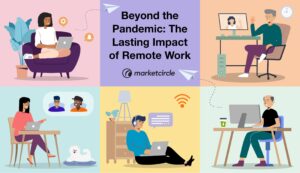If you’re interested in making the change to remote work, but you’re not quite sure how or what mistakes to avoid, hopefully, you’ll find our experience helpful as you navigate your own transition.

Benefits of working remotely
- Less overhead with a smaller office
- Fewer sick days because people don’t spread colds and flus as easily
- More flexibility with scheduling
- Less commuting
- Expanded talent pool
- Less distractions = more focused work
Another benefit (and also challenge) of working remotely is that it forced us to establish more discipline and better processes for improving communication and organization.
Challenges of working remotely
- Communication
- Onboarding new employees
- Keeping our culture alive
- Maintaining company alignment on goals and reasons behind major decisions
Making the transition to working remotely
We didn’t make the transition to a remote company overnight. It took us years. We tested it first with a few engineers to allow them more focused work and less distractions. It also allowed more flexibility because a lot of our engineers work best in the evening and aren’t as productive first thing in the morning. After experimenting, we saw it worked and decided it was a goal worth working towards.
We started giving people the option to work from home two days a week. Then we expanded to one week in-office, one week work-from-home. From there, we opened it up to two consecutive weeks working from home. Then we tried working from home almost all the time, with the exception of coming into the office once a month for our All Hands. Most recently, we transitioned to doing our All Hands remotely and hiring employees that work 100% remotely.
Hiring remote workers was also something that happened gradually. We started by expanding our boundaries for hiring within a 4-5 hour radius. These employees still came into the office once a month for All Hands and team building events. Then we gradually expanded to hiring people anywhere so long as they were within the same time zone. Then we expanded further to hiring people with a 3-4 hour difference in time zone. We haven’t yet expanded to hiring people in completely different timezones with no overlapping work hours. It’s something we’re considering in the future.
Making this transition gradually allowed us to change, adapt, and improve our processes – as well as tools – to overcome the challenges of working remotely.
How we maintain communication and keep our culture alive
As I mentioned above, transitioning to working remotely forced us to become a lot more disciplined in our processes for keeping communication flowing between all employees so everyone remains aligned on our goals. It also forced us to be deliberate about keeping our culture alive and how we could create an environment where our core values kept us true to our nature as a company and as a team.
Here are some of the things we’ve implemented to improve communication and a healthy culture:
Monthly All Hands
Every month we rally everyone together to talk about our goals, challenges, and priories for the year. We break them down into quarterly priorities and use this time to share not just our progress on our goals, but also to do a deep-dive into the challenges we’re facing, what we’re doing to overcome those challenges, along with decisions we’ve made and the reasons behind those decisions. We’ve found this helps everyone stay aligned and focused on our top priority.
We used to do our All Hands in-office but we’ve since transitioned to doing these remotely over Zoom. We’ve also started incorporating a Q&A at the end of every All Hands and use the chat feature in Zoom for people to ask questions. We’ve found this gets more engagement than in person because it’s less intimidating to chat a question over Zoom than to ask something in front of the entire company.
Props channel
When we first defined our core values, we created a wall in the office with everyone’s photo and post-it notes of our core values – Creativity, Empathy, Teamwork, Ownership, and Kaizen. People would give each other props for living our core values by writing down what they did on a post-it note with the core value on it and stick it to their photo. At the end of the month, we’d hand the employee the sticky notes to keep.
When we began working from home more often than we worked in the office, we decided to try doing this over Slack. We created a Props channel in Slack where people would give each other props for living our core values. This got even more engagement than the Props Wall and made it more visible to the entire company, allowing others to cheer on their colleagues as well.
Weekly team meetings
To keep everyone focused on our top priority, raise bottlenecks, and collaborate on ideas, we have weekly team meetings. Each department has a weekly meeting and the executive team also meets together weekly. These meetings happen over Zoom and are usually about an hour. The purpose of these meetings is to recap our top priority, review important stats or top issues, raise issues or bottlenecks, raise customer and employee feedback, and share important learnings and insights.
We used to also have daily huddles for each team, but for some teams, a daily huddle proved to be overkill, so some teams have transitioned to a huddle every other day or just the weekly meeting. What works for one department, doesn’t work for everyone so we give teams autonomy to do what works best for them.
One-on-ones
Each employee has a one-on-one with their manager every other week or on a weekly basis. These meetings happen over Zoom and are usually about 30 minutes long. These one-on-ones allow managers time to coach their team members, listen to feedback, help remove bottlenecks, and help each employee understand how they contribute to our overall goal as a company.
Social Committee
We created a Social Committee responsible for organizing exciting events to ensure our team members get proper amounts of workplace fun and keep our core values alive. Hence, we always have something to look forward to. From virtual team lunches and Slack contests to game nights and in-person events, our Social Committee does a great job ensuring we always have an opportunity to connect with our colleagues and foster friendships in the workplace.

Shine Bright Award
On top of using the props channel in Slack to reward each other for living our core values, we also included them in our employee Scorecards because staying true to our core values is just as important as meeting your KPIs (Key Performance Indicators).
We have, however, taken it a step further to weave our values tighter into the fabric of our company. We accomplished that by creating the Shine Bright Awards, a monthly incentive for our team members to live our core values on a daily basis, defining what it means to be a shining example of Ownership, Creativity, Kaizen, Teamwork, and Empathy.
This way it’s not a gut feeling as to whether or not an employee is living our core values, it’s much clearer and more concrete. This helps provide clarity for people on what specifically they can do to improve, as well as recognition for people that are shining examples.
How we’re onboarding new employees remotely
During the early years of our transition to working remotely, onboarding new employees still happened in-office. But once we started hiring employees in different countries and timezones, it forced us to rethink how we onboarded new hires.
To do this, we ramped up documentation on Confluence to provide new hires a starting point and to guide their learning. We implemented intro meetings for new hires with each department VP and/or Manager over Zoom. This way new hires could be introduced to the different departments and get an idea for how they work, what they’re focused on, and challenges they face.
We started using our About Us page as an onboarding tool so new hires could learn more about their co-workers and put faces to names in Slack. We also beefed up our Daylite checklists (Activity Sets) to make sure we’re following the steps to set new employees up for success.
Apps we use to collaborate
I’ve mentioned most of the tools we use already above, but here’s a quick summary of the key tools we use to collaborate.
Zoom for meetings.
Confluence for documenting processes, scoping projects and plans, commenting on ideas, posting mock-ups, etc.
Slack for messaging individuals in private chats, teams for group chats, or the whole company for updates.
Daylite for scheduling meetings, delegating tasks, organizing & tracking projects, coordinating our content calendar and more.
Shared Numbers & Pages to track stats and collaborate on documents.
Jira to coordinate tasks for our developers, tracking bugs, and feature requests.
Freeform for brainstorming and collaboration on creative projects between teams.
Email as a last resort.
Summary
When we made the decision to start transitioning to a remote company we knew a risk was losing some people that just weren’t a good fit for the remote life, and it would also mean a lot of changes and challenges. Those were risks we were willing to take in order to create the work environment we craved which allowed for more travel, flexibility, broader talent pool, and more freedom. The transition wasn’t easy. It took a lot of effort and discipline to review what wasn’t working and creatively find solutions to those problems.
If you’re determined, you’ll figure out ways to make it work. We’re happy we did. 🙂
About the author:
Kristie Holden is the former VP of Marketing at Marketcircle/Daylite. She’s now an online marketing consultant. She helps startups get more leads by clarifying their message and creating a marketing strategy to attract and convert their ideal client. Connect with her on Instagram.

